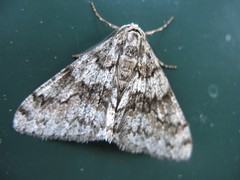After a winter full of snowbanks, and a late winter with way too much rain, there was a spell of fine sunny warm weather last week. That was all the early-season moths needed. My first moth of the season may have been a Fall Cankerworm Moth (Alsophila pometaria) but the photos weren't quite good enough to clinch it. Soon afterward, I saw the first Spring Cankerworm Moth (Paleacrita vernata) of the season, a browner individual than the gray ones I've seen in past years.
Yesterday I decided to visit Plainsboro Preserve on the off chance some moths were perched on the building (they are attracted from the surrounding area by the building's lights). I wasn't expecting much, but was delighted to find several The Half-wings (Phigalia titea), more Spring Cankerworm Moths, as well as various unidentified Noctuids and others. Spring has officially sprung, as far as the moths are concerned.
In other mothiness around the web, the most recent The Moth and Me blog carnival has been posted at the Xenogere blog. Some female moths are wingless, and a nice video clip of such a female is part of the carnival (not to mention a whimsical conversation with her, but that's another story). I've never seen one of these wingless moths, so it was a great opportunity to see what they look like in real life.
Also, Seabrooke Leckie at The Marvelous in Nature has an interesting post about creating range maps for the upcoming Peterson series field guide to moths, and the dilemma of what to do when one doesn't have a lot of data from which to generate a range map.

2 comments:
Thanks for the links! I suspect most people would probably just put the existing textual range descriptions in the book and forgo any visual map, but the whole point of the guide was to make something that was easy to use, and I think most users struggle with text ranges. I'm expecting a mixed response to the maps because of how they were prepared, but you can't please everyone and I'm generally satisfied with them.
Hi Seabrooke,
You're welcome! I'm going to try to make Mothy Monday a bit more regular than it has been in the past.
Given how much birders like to debate the features of their favorite/not-so-favorite field guides, I expect the moth guide will attract a similar kind of attention on a smaller scale. I'm fortunate because I live in a small state with distinct ecoregional boundaries (and probably a fair amount of data to work with), so I expect the maps will work very well here in NJ. Elsewhere in North America, though, it could get a bit more interesting.
Hopefully the guide will get more people looking at moths. Then, for the second edition, you will have lots more data to work with, so the maps can be refined accordingly. ;)
Post a Comment